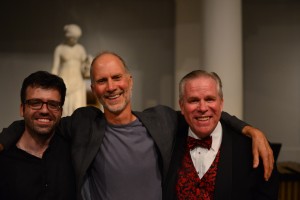John Luther Adams At The University of Michigan
Last night marked the launch of Pulitzer Prize-winning composer John Luther Adams’ weeklong residency at the University of Michigan. Adams’ time in Ann Arbor, which will include performances as well as lectures on environmental advocacy, began with an evening of his chamber music at the University of Michigan Museum of Art. The museum’s apse has been site of may memorable concerts over the years, but none may have taken advantage of this setting as well as yesterday’s program of Adams’ resonant and ravishing compositions. In one of the handful of interstitial interviews between Adams and University of Michigan Musicology Professor Mark Clague, the composer described his music as, “all about sound and space.” And, Adams later added, “I want to make strange and beautiful new places…make them empty, without my footprints in them…so the audience can find their way through them.”

The hundreds in attendance Monday night had a terrific opportunity to experience these characteristics in Adams’ works Strange Birds Passing, Dark Wind, The Farthest Place, In a Treeless Place, Only, and in four selections from his massive choral work Canticles of the Holy Wind. In between the pieces, Adams shared evocative and endearing anecdotes related each work’s origins. These included the revelation that the Strange Birds Passing was inspired by the paisley wallpaper decorating Adams’ Alaskan cabin’s refrigerator in the 1980s, or that the selected movements from Canticles of the Holy Wind reflect his more recent observations of parhelia and other celestial phenomena in the sky above the arctic and Mexico.
The concert’s program was, essentially, chronological, and enabled Adams to recount his sense of his growth as a composer. Fond of and familiar with his music, I listened for large-scale similarities and differences across the evening’s offerings. Certainly, The Farthest Place and Dark Wind – which Adams denoted as two of his, “color field pieces,” – work through deeply similar designs. The oldest piece, Strange Birds Passing, was the most overtly melodic composition, yet it evinced the same ambling, symmetrical form expressed by In a Treeless Place, Only Snow and Canticles of the Holy Wind. Altogether, Monday’s concert was a terrific aperitif to the culmination of Adams’ time in Ann Arbor: the University Symphony Orchestra’s performance of Become Ocean, which represents the work’s Midwest premiere. Even that piece, Adams’ most recent and celebrated, had ancestors of last evening’s program, as one could here embryos of Become Ocean in Dark Wind’s trembling opening.
In the end, as much as Adams’ music amazed, the setting of its performance was almost more stunning. At the very least – and as Adams admitted – the museum’s acoustics had as much a hand in the beauty of the evening’s performance as did the talented instrumentalists and vocalists of Michigan’s School of Music, Theatre, and Dance, or Adam’s compositional artistry. Perhaps the most remarkable aspect of the concert was Adams’ willingness to collaborate with, and have his listeners’ experience so heavily influenced by, the space surrounding the performance. As Adam’s described, it seems he tries, in all his pieces, to remove himself as much as possible from the music, from the center of the audience’s attention. I think many composers aspire towards the humility needed to even consider this kind of rhetorical positioning, but few live in it like Adams seems to. And, though I doubt it is even possible for any composer to disappear fully from a listener’s experience of their music, Adams’ efforts to this end, like his compositions, are, indeed, superlative.